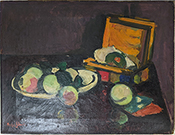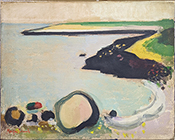Born: Lodz, Poland, November 11, 1909
Died: New York City in 1970
Education:
The Sorbonne in Paris
The Academie de la Grande Chaumiere in Paris
The Art Students League in New York
The National Academy of Design in New York
Studied with Charles Hawthorne, John Sloan, and George Bridgemen
Exhibited with Edward Hopper, Maurice de Vlaminck, Andrew Wyeth
Owned and directed an art gallery at 144 West 13th Street, New York, N.Y. from 1931 to 1934
Manfred Schwartz is widely regarded as one of the great academic painters of this era.
“It takes so long to become one’s self”, this was one of the last things Manfred Schwartz said to his son Paul Waldo Schwartz. In his lifetime Manfred Schwartz created a sensational body of work in oil, pastel, and in a series of hand pulled stone lithographs. His career as a professional artist spanned fifty years and encompassed three major artistic periods.
His earliest paintings, portraits and still lifes, were created and exhibited in the 1930’s. His use of color was subdued, preferring umbers and grays to the vivid colors he used in later years. In 1940 he began to paint more abstract figures, and by the mid 1950’s through the mid 1960’s Manfred Schwartz created a series of limited edition hand pulled stone lithographs at the famed Mourlot Studios in Paris.
Born in Poland in 1909 Manfred Schwartz came to America when his father, a master engraver to European royalty, was brought to New York by the Colgate Palmolive Company. As a young man, eager to experience the world, Manfred Schwartz returned to Paris to study. It was in Paris where Schwartz met and associated with some of the great masters of the 20th century, Braque, Roualt, Picasso, and Matisse.
Although he considered himself an artist first and foremost, Manfred Schwartz had a well-rounded life. An accomplished musician, Manfred Schwartz played the cello and the piano. He was also a gifted writer, a wordsmith who was known to be a magnificent conversationalist. With this circle of artist and art dealer friends he often talked through the night, taking up the occasional chess game.
Henri Matisse was forty years Manfred’s senior and already a famous artist when he met Manfred Schwartz and was impressed with his unique insight and original use of color. Matisse took Schwartz under his wing and advised him to go to Etretat, France for the light and inspiration. It was advise that would soon make Manfred Schwartz the toast of New York City’s art world.
Manfred’s time spent in Etretat was the beginning of a highly sought after body of work. His unique style and breathtaking color compositions were exhibited and sold by art galleries in New York and Paris, and purchased for the permanent collections of some of the most prestigious art museums in the world including the Guggenheim and the Whitney.
Among Manfred’s inner circle of artists were Marcel Duchamp, Manfred’s senior by 22 years, and Roberto Matta who was Manfred’s contemporary. Many of the influences by these great artists were absorbed by Manfred Schwartz however without interfering with his own particular exploration of color and light.
With a burst of creativity that carried Manfred Schwartz through the next two decades, the artist challenged himself and created several series of paintings. The work was unified by a theme of semi-abstract images. The very realistic European figures of his early Parisian training had begun to evolve and disintegrate in the 1950's. Evidence of this evolution of work can be seen in Manfred’s Acrobat Series.
In 1960 Manfred Schwartz created the Ring Series, images that keenly denote a Matissian influence. In the same decade, after finishing the Ring Series, Manfred moved on to the Etretat Series showing the pebbles on beach at Etretat and the way the sunlight drifts through the tiny circles creating larger concentric circles. When real light plays upon the painted light of Manfred’s Etretat Series the effect is a visual sensation of movement.
In the same decade came his geometric images of knights in armor that were created in oils and pastels. As one looks at these semi-abstract works of art one is reminded of Duchamp’s Nude Descending a Staircase and its power in creating movement. The cluster of knights in each painting have that same feeling of movement. They are classic knights in armor but thoroughly modern in composition and form. It is an intellectual game on canvas. One can imagine Schwartz sitting in the park of the Palace du Luxembourg playing a game of chess and the image forming in his mind. These images of marching knights and knights on horseback are Manfred’s last works to contain figures.
He was not an old man when he died, but Manfred Schwartz did live to enjoy a fruitful and respected art career. Manfred Schwartz passed away at the age of 61. He one of the most successful living artists in New York and was at the time of his death under contract to the renowned Knoedler Gallery in New York. The Knoedler held two posthumous exhibits, and The Rhode Island School of Design and the Whitney Museum both gave retrospective exhibitions shortly after Manfred passed.
Since then almost four decades have passed, and the work of Manfred Schwartz lives on. Art collectors from around the world find pleasure in the company of such a distinguished artist’s work. His work on the open market is becoming increasingly rare; the lithographs were created in very small editions, some as small as 25 pieces worldwide. Even more rare, an original oil or pastel coming into the light of an art gallery. The pastels have retained their brilliance, and the images themselves still engage the mind.
Art Galleries from New York to California still show Manfred’s hand pulled stone lithographs. The originals are becoming more rare with each passing year, but they can still be found and collected. The pastels have retained their brilliance, and the images still engage the mind.
PERMANENT COLLECTIONS
The Brooklyn Museum, NY
The Chrysler Museum, VA
The Metropolitan Museum of Art, NY
The Museum of Modern Art, NY
New School for Social Research Art Center, NY
New York Public Library, NY
The Newark Museum, NJ
Philadelphia Museum of Art, PA
Solomon R. Guggenheim Museum, NY
University of Minnesota University Gallery, MN
Whitney Museum, NY
SOLO EXHIBITIONS
Lilienfeld, NY: 1940, 1941, 1942, 1943
Durand Ruel, Paris: 1946, 1947, 1949
Otto Gerson, NY: 1953, 1955, 1956, 1957, 1958
Albert Landry, NY: 1962, 1963
New School, NY: 1964
Wientraub Gallery, NY: 1984
Modern Art Gallery, Boca Raton, FL: 1996
SOLO RETROSPECTIVES
The Brooklyn Museum, NY: 1961
The Whitney Museum, NY: 1971
The Rhode Island School of Design Museum, RI: 1974
Knoedler Gallery, NY: 1974, 1978
GROUP EXHIBITIONS
World Art Gallery, Ladera Ranch, Orange County, CA
Albright-Know Art Gallery, Buffalo, NY
Musee' Cantini, Marseille, France
National Academy Gallery, New York, NY
Skowhegan, ME
Brooklyn Museum, NY
Fine Art Associates, NY
Cincinnati Art Museum, OH
Milwaukee Art Center, WI
Corcoran Gallery of Art, Washington, DC
Durand Ruel Gallery, Paris, France
Carnegie Institute, Washington, DC
Rochester Memorial Art Gallery, NY
Wadsworth Athenaeum, Hartford, CT
The St. Paul Art Gallery, MN
Institute of Contemporary Art, Boston, MA
M. Young Memorial Museum, San Francisco, CA
Joslyn Art Museum, Omaha, NE
World Art Gallery, Ladera Ranch, CA
Los Angeles County Museum of Art, CA
BIBLIOGRAPHY
New York Times, Art Critic John Canaday, 1962
New York Times, November 1970
New York Times, Hilton Kramer, 1971
New York Times, Peter Schjeldahl, September 1971
New York Times, Hilton Kramer, April 1974
The New Yorker Magazine
Arts Magazine, January 1985
Architectural Digest, November 1987
Art & Antiques Magazine, November 1988

